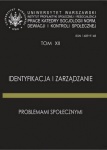Czemu dziś służą i od czego zależą społeczne interwencje aparatu ścigania i wymiaru sprawiedliwości w sprawach karnych?
What Are the Purposes and Conditions of Action for Social Interventions of Prosecution and Judicial Bodies Today?
Author(s): Jan WinczorekSubject(s): Social Sciences
Published by: Instytut Profilaktyki Społecznej i Resocjalizacji UW
Keywords: juridical bodies; Niklas Luhmann; prosecution bodies; social intervention
Summary/Abstract: The paper aims at explaining an apparent contradiction in criminal statistics in Poland. During the last few years, despite a sharp decline in reported crime, we have been observing the stabilization of incarceration rates at high levels. Three factors are identified as contributing to this state of affairs, i.e. legal changes, including the criminalization of a number of new offences, substantial changes in the structure of reported crime and the overcrowding of prisons, which limits the growth of incarceration rates stimulated by two other abovementioned conditions. Moreover, it has been established that a number of modifications in the criminal law, including the criminalization of drunk driving, the possession of psychoactive substances or some forms of pornographic materials, as well as amendments to the provisions of the Criminal Code regarding corruption, have had a specific impact on criminal statistics. As opposed to “regular” crimes, where crime detection usually precedes its clearance, in most cases of newly criminalized acts the detection is concurrent to clearance. This has a very strong, positive effect on police clearance rates, to such extent that an impressive growth of clearance rate of Polish police over the last ten years (by more than 50%) can be entirely attributed to the criminalization of most frequent among new crimes: drink-driving and drug possession. The paper also assumes that the same explanation may be given to the stabilization of incarceration rates. Furthermore, it proposes the interpretation of the activities and attitudes of the police, criminal administration and the public at large. It holds that the those amendments and the way in which these are used stem from independent strategies of each of those social actors, pursuing their own collective goals and adapting themselves to external conditions and available resources. All findings of the paper are interpreted by means of Niklas Luhmann’s circular model of state intervention, as presented in his 1981 book Political Theory in the Welfare State. The conclusion of the paper is that Polish criminal intervention is becoming more and more technocratic in its action yet more and more virtual in its effects.
Journal: Prace Katedry Socjologii Norm, Dewiacji i Kontroli Społecznej
- Issue Year: 2011
- Issue No: 12
- Page Range: 14-43
- Page Count: 30
- Language: Polish

